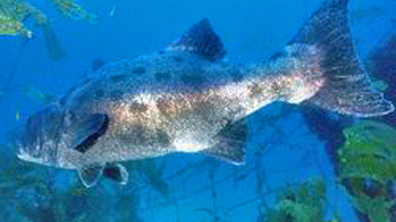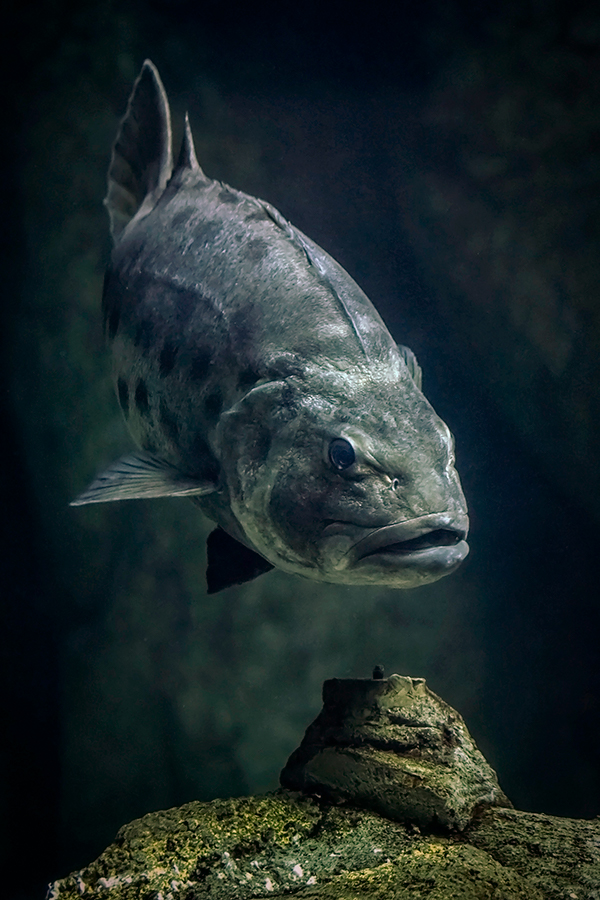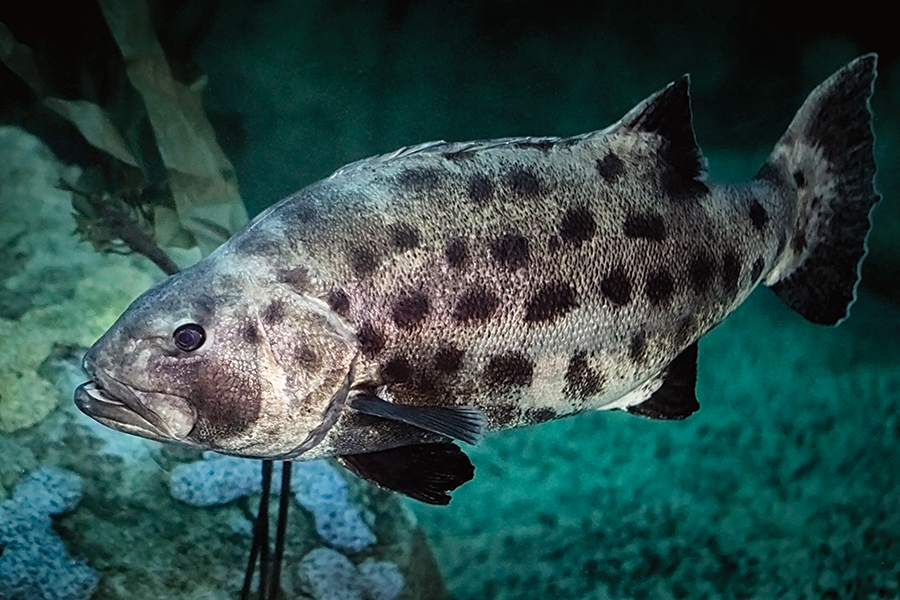Giant Sea Bass
Stereolepis gigas
Giant sea bass are also known as black sea bass. Their dark spots come and go, but when these fish die, they are a uniform very dark brownish-black, hence the common name, black bass. In spite of their size, they are gentle giants, easily approached by divers. Almost hunted to extinction, in 1988 the California legislature passed a law to protect them, and their numbers appear to be increasing in California waters.

Giant sea bass in the Channel Islands Sanctuary Credit: Courtesy of NOAA

Giant Sea Bass in the Blue Cavern Exhibit. Credit: Robin Riggs

Credit: Robin Riggs
SPECIES IN DETAIL
Giant Sea Bass
Stereolepis gigas
CONSERVATION STATUS: Endangered - Protected
CLIMATE CHANGE: Uncertain
At the Aquarium
The Aquarium has three giant sea bass under a special permit from the California Department of Fish and Wildlife. The two larger ones have inhabited the Honda Blue Cavern exhibit since 1998, and we have identified them as male and female (the larger of the two) because of their spawning behavior. It is believed they may be about 30 years old based on their size and spawning behavior. The third fish came to the Aquarium in 2012. Our aquarists believe it is a male based on behavior and interaction between it and the older giant sea bass. Our breeding pair produced an offspring at in 2016. This young fish, named Yutaka, lives in the Amber Forest exhibit.
Geographic Distribution
Northwest Pacific Ocean from Humboldt, California, to the Gulf of California
Habitat
Adult giant sea bass tend to inhabit the edges of nearshore areas with rock bottoms where kelp beds are nearby and drop-offs usually at depths deeper than 30 m (66 ft). Juveniles are usually found near or in kelp beds on sand or mud bottoms at depths of 21 m (69 ft). Studies using acoustic tags have shown that these fish spend summer months in shallower waters and migrate to deeper waters during the winter months.
Physical Characteristics
Adult giant sea bass have a bulky robust body with a single strongly notched dorsal fin that fit into a groove on the back, and a broad flat tail. The head and mouth are large. The teeth are small and in the back of the mouth.
Giant sea bass change color during their lifespan. Adults are usually a grayish-black to dark brown in color on except for the belly which is much lighter. This coloration is called countershading. At times they may have dark spots on their sides. Perch-like in appearance, juveniles differ considerably from adults and are often mistaken for a different fish species. They have a sandy-red to orange body with white and dark patches scattered along the sides. The body spots are more permanent in juveniles.
Diet
Giant sea bass are apex predators that fed on a variety of food items including crustaceans, rays, skates, squid, bony fish species (anchovies, sheephead, sand dabs, flounder, croaker), and sometimes even kelp. When feeding, a giant sea bass rapidly opens its mouth creating a vacuum with which to suck in water and prey. Not built for speedy swimming, much of their prey is bottom dwelling organisms.
Reproduction
Sexual maturity appears to be reached at ten to thirteen years of age. During spawning season from June to September adults gather in groups of two to twenty fish. Males may nudge females to release eggs, which the males will fertilize. During spawning season a female may produce up to 60 million eggs. Once fertilized, the eggs swell up, become positively buoyant, and float to the surface. Within twenty-four to thirty-six hours the eggs will hatch into larvae. The newly hatched larvae will feed on plankton while drifting for approximately a month. Then, they will then sink and begin their juvenile phase.
Behavior
Giant sea bass can be very curious, and are known to swim near divers to investigate them. They spend much of its time in kelp forests and rocky reefs waiting to ambush prey.
Although the majority of their time is spent moving slowly, despite their size they can move very quickly for a short time. They have even been reported aiming faster than bonito over short distances. Four individuals have been tracked migrating annually between Anacapa and Catalina islands, a distance of 50 nautical miles, in about 27 hours.
Adaptation
The coloration of giant sea bass coloration helps them blend in with their surroundings in rocky reefs and the shadows of kelp forests, but their large size is their its primary protection. Their ability to make their dark spots appear and disappear is a form of camouflage.
Longevity
At least 50 years. The oldest known specimen to date was 72 years old.
Conservation
Giant sea bass populations are believed to be increasing slowly after years of decline but there is no scientific evidence to that effect. They are listed internationally as critically endangered and are protected in California. Legislation passed in 1988 and in force today prohibits commercial or recreational fishing for giant sea bass. If accidentally caught, they must be released. In 1990 use of gill nets near the California coast decreased the bycatch of these fish. Propagation of this species in research laboratories and other facilities has not been successful to date although fit has been attempted with recovered fertilized eggs.
These sea bass can still be caught in Mexico but they have been so overfished that they are rarely caught.
Special Notes
The giant sea bass can rapidly and dramatically change color, revealing white mottling or dark spots which are believed to be used in communicating stress or other signals to nearby members of the same species.
The giant sea bass is so large that when fully grown, it’s only known predators are the great white shark and human beings.
SPECIES IN DETAIL | Print full entry
Giant Sea Bass
Stereolepis gigas
CONSERVATION STATUS: Endangered - Protected
CLIMATE CHANGE: Uncertain
The Aquarium has three giant sea bass under a special permit from the California Department of Fish and Wildlife. The two larger ones have inhabited the Honda Blue Cavern exhibit since 1998, and we have identified them as male and female (the larger of the two) because of their spawning behavior. It is believed they may be about 30 years old based on their size and spawning behavior. The third fish came to the Aquarium in 2012. Our aquarists believe it is a male based on behavior and interaction between it and the older giant sea bass. Our breeding pair produced an offspring at in 2016. This young fish, named Yutaka, lives in the Amber Forest exhibit.
Northwest Pacific Ocean from Humboldt, California, to the Gulf of California
Adult giant sea bass tend to inhabit the edges of nearshore areas with rock bottoms where kelp beds are nearby and drop-offs usually at depths deeper than 30 m (66 ft). Juveniles are usually found near or in kelp beds on sand or mud bottoms at depths of 21 m (69 ft). Studies using acoustic tags have shown that these fish spend summer months in shallower waters and migrate to deeper waters during the winter months.
Adult giant sea bass have a bulky robust body with a single strongly notched dorsal fin that fit into a groove on the back, and a broad flat tail. The head and mouth are large. The teeth are small and in the back of the mouth.
Giant sea bass change color during their lifespan. Adults are usually a grayish-black to dark brown in color on except for the belly which is much lighter. This coloration is called countershading. At times they may have dark spots on their sides. Perch-like in appearance, juveniles differ considerably from adults and are often mistaken for a different fish species. They have a sandy-red to orange body with white and dark patches scattered along the sides. The body spots are more permanent in juveniles.
Giant sea bass are apex predators that fed on a variety of food items including crustaceans, rays, skates, squid, bony fish species (anchovies, sheephead, sand dabs, flounder, croaker), and sometimes even kelp. When feeding, a giant sea bass rapidly opens its mouth creating a vacuum with which to suck in water and prey. Not built for speedy swimming, much of their prey is bottom dwelling organisms.
Sexual maturity appears to be reached at ten to thirteen years of age. During spawning season from June to September adults gather in groups of two to twenty fish. Males may nudge females to release eggs, which the males will fertilize. During spawning season a female may produce up to 60 million eggs. Once fertilized, the eggs swell up, become positively buoyant, and float to the surface. Within twenty-four to thirty-six hours the eggs will hatch into larvae. The newly hatched larvae will feed on plankton while drifting for approximately a month. Then, they will then sink and begin their juvenile phase.
Giant sea bass can be very curious, and are known to swim near divers to investigate them. They spend much of its time in kelp forests and rocky reefs waiting to ambush prey.
Although the majority of their time is spent moving slowly, despite their size they can move very quickly for a short time. They have even been reported aiming faster than bonito over short distances. Four individuals have been tracked migrating annually between Anacapa and Catalina islands, a distance of 50 nautical miles, in about 27 hours.
The coloration of giant sea bass coloration helps them blend in with their surroundings in rocky reefs and the shadows of kelp forests, but their large size is their its primary protection. Their ability to make their dark spots appear and disappear is a form of camouflage.
At least 50 years. The oldest known specimen to date was 72 years old.
Giant sea bass populations are believed to be increasing slowly after years of decline but there is no scientific evidence to that effect. They are listed internationally as critically endangered and are protected in California. Legislation passed in 1988 and in force today prohibits commercial or recreational fishing for giant sea bass. If accidentally caught, they must be released. In 1990 use of gill nets near the California coast decreased the bycatch of these fish. Propagation of this species in research laboratories and other facilities has not been successful to date although fit has been attempted with recovered fertilized eggs.
These sea bass can still be caught in Mexico but they have been so overfished that they are rarely caught.
The giant sea bass can rapidly and dramatically change color, revealing white mottling or dark spots which are believed to be used in communicating stress or other signals to nearby members of the same species.
The giant sea bass is so large that when fully grown, it’s only known predators are the great white shark and human beings.

